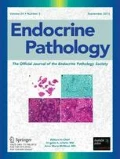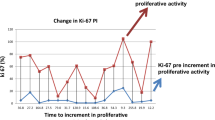Abstract
Gastroenteropancreatic neuroendocrine tumors (GEP-NETS) are unusual and rare neoplasms for which prognostic assessment and the diagnosis of malignancy, on the basis of histology alone, represent considerable challenges for the pathologist. To date, many molecular markers have been identified with a view to providing accurate and timely prediction of response to treatment and long-term survival. Proliferation remains a key feature of tumor progression, which has been widely estimated by the immunohistochemical use of the Ki-67 nuclear antigen. Given the continued difficulties inherent in prediction of malignancy in pancreatic neuroendocrine tumors (PETs) in particular, it has become unclear whether Ki-67 is truly a reliable prognostication marker. This review seeks to better establish what the consensus is on the role of the Ki-67 proliferation index as a prognostic indicator of long-term outcome in pancreatic neuroendocrine tumors. We conclude that most studies favor the utility of the Ki-67 proliferation index despite different critical percentages and in concert with other pathological parameters in the routine work-up of PETs.
Similar content being viewed by others
References
Modlin IM, Lye KD, Kidd M. A 5-decade analysis of 13,715 carcinoid tumors. Cancer 97:934–61, 2003. doi:10.1002/cncr.11105.
Maggard MA, O’Connell JB, Ko CY. Updated population-based review of carcinoid tumors. Ann Surg 240:117–22, 2004. doi:10.1097/01.sla.0000129342.67174.67.
White TJ, Edney JA, Thompson JS, Karrer FW, Moor BJ. Is there a prognostic difference between functional and nonfunctional islet cell tumors? Am J Surg 168:627–30, 1994. doi:10.1016/S0002-9610(05)80134-5.
Rothenstein J, Cleary SP, Pond GR, Dale D, Gallinger S, Moore MJ, Brierley J, Siu LL. Neuroendocrine tumors of the gastrointestinal tract: a decade of experience at the Princess Margaret Hospital. Am J Clin Oncol. 31:64–70, 2008.
Kent RB, Van Heerden JA, Weiland LH. Nonfunctioning islet cell tumors. Ann Surg 193:185–90, 1981. doi:10.1097/00000658-198102000-00010.
Evans DB, Skibber JM, Lee JE, Cleary KR, Ajani JA, Gagel RF, Selling RV, Fenoglio CJ, Merrell RC, Hickey RC. Nonfunctioning islet cell carcinoma of the pancreas. Surgery 114:1175–81, 1993 discussion 1181–2.
Bartsch DK, Schilling T, Ramaswamy A, Gerdes B, Celik I, Wagner HJ, Simon B, Rothmund M. Management of nonfunctioning islet cell carcinomas. World J Surg 24:1418–24, 2000. doi:10.1007/s002680010234.
Solorzano CC, Lee JE, Pisters PW, Vauthey JN, Ayers GD, Jean ME, Gagel RF, Ajani JA, Wolff RA, Evans DB. Nonfunctioning islet cell carcinoma of the pancreas: survival results in a contemporary series of 163 patients. Surgery 130:1078–85, 2001. doi:10.1067/msy.2001.118367.
Gullo L, Migliori M, Falconi M, Pederzoli P, Bettini R, Casadei R, Delle Fave G, Corleto VD, Ceccarelli C, Santini D, Tomassetti P. Nonfunctioning pancreatic endocrine tumors: a multicenter clinical study. Am J Gastroenterol 98:2435–9, 2003. doi:10.1111/j.1572-0241.2003.07704.x.
Capella C, Heitz PU, H6fler H, Solcia E, Kloppel G. Revised classification of neuroendocrine tumors of the lung, pancreas and gut. Virchows Arch 425:547–60, 1995. doi:10.1007/BF00199342.
Rindi G, Capella C, Solcia E. Introduction to a revised clinicopathological classification of neuroendocrine tumors of the gastroenteropancreatic tract. Q J Nucl Med 44:13–21, 2000.
Klöppel G, Perren A, Heitz PU. The gastroenteropancreatic neuroendocrine cell system and its tumors: the WHO classification. Ann N Y Acad Sci 1014:13–27, 2004. doi:10.1196/annals.1294.002.
Chetty R. Requiem for the term ‘carcinoid tumor’ in the gastrointestinal tract? Can J Gastroenterol 22:357–8, 2008.
Faggiano A, Mansueto G, Ferolla P, Milone F, del Basso de Caro ML, Lombardi G, Colao A, De Rosa G. Diagnostic and prognostic implications of the World Health Organization classification of neuroendocrine tumors. J Endocrinol Invest 31:216–23, 2008.
Wick MR, Graeme-Cook FM. Pancreatic neuroendocrine neoplasms: a current summary of diagnostic, prognostic, and differential diagnostic information. Am J Clin Pathol 115:S28–45, 2001. doi:10.1309/EBTU-VHB0-Y88P-FKA8.
Rindi G, Klöppel G, Ahlman H, Caplin M, Couvelard A, de Herder WW, Erikssson B, Falchetti A, Falconi M, Komminoth P, Korner M, Lopes JM, McNicol AM, Nilsson O, Perren A, Scarpa A, Scoazec JY, Wiedenmann B, all other Frascati Consensus Conference participants: European Neuroendocrine Tumor Society (ENETS). TNM staging of midgut and hindgut (neuro) endocrine tumors: a consensus proposal including a grading system. Virchows Arch 449:395–401, 2006. doi:10.1007/s00428-006-0250-1.
La Rosa S, Klersy C, Uccella S, Dainese L, Albarello L, Sonzogni A, Doglioni C, Capella C, Solcia E. Improved histologic and clinicopathologic criteria for prognostic evaluation of pancreatic endocrine tumors. Hum Pathol. 2008 Aug 18.
Solcia E, Sessa F, Rindi G, Bonato M, Capella C. Pancreatic endocrine tumors: general concepts; nonfunctioning tumors and tumors with uncommon function. In: Dayal Y, ed. Endocrine pathology of the gut and pancreas. Boca Raton, Fla: CRC, pp. 105–31, 1991.
Donow C, Baisch H, Heitz PU, Kloppel G. Nuclear DNA content in 27 pancreatic endocrine tumors: correlation with malignancy, survival and expression of glycoprotein hormone alpha chain. Virchows Arch 419:463–8, 1991. doi:10.1007/BF01650673.
Kenny BD, Sloan JM, Hamilton PW, Watt PCH, Johnston CF, Buchanan KD. The role of morphometry in predicting prognosis in pancreatic islet cell tumors. Cancer 64:460–465, 1989. doi:10.1002/1097-0142(19890715)64:2<460::AID-CNCR2820640220>3.0.CO;2-F.
Hoffler H, Ruhri C, Ptitz B, Wirnsberger G, Hauser H. Oncogene expression in endocrine pancreatic tumors. Virchows Arch 55:355–61, 1988.
La Rosa S, Sessa F, Bosi F, Fabbri A, Capella C. Prognostic factors in nonfunctioning pancreatic endocrine tumors. Lab Invest 72:54A, 1995.
Pelosi G, Zamboni G, Doglioni C, Rodella S, Bresaola E, Iacono C, Serio G, Iannucci A, Scarpa A. Immunodetection of proliferating cell nuclear antigen assesses the growth fraction and predicts malignancy in endocrine tumors of the pancreas. Am J Surg Pathol 16:1215–25, 1992. doi:10.1097/00000478-199212000-00008.
Scholzen T, Gerdes J. Ki-67 protein: from the known and the unknown. J Cell Physiol 182:311–22, 2000. doi:10.1002/(SICI)1097-4652(200003)182:3>311::AID-JCP1>3.0.CO;2-9.
Endl E, Gerdes J. The Ki-67 protein: fascinating forms and an unknown function. Exp Cell Res. 257:231–7, 2000. doi:10.1006/excr.2000.4888.
Brown DC, Gatter KC. Ki67 protein: the immaculate deception? Histopathology. 40:2–11, 2002. doi:10.1046/j.1365-2559.2002.01343.x.
Bruno S, Darzynkiewicz Z. Cell cycle dependent expression and stability of the nuclear protein detected by Ki-67 antibody in HL-60 cells. Cell Prolif 25:31–40, 1992. doi:10.1111/j.1365-2184.1992.tb01435.x.
Bridger JM, Kill IR, Lichter P. Association of pKi-67 with satellite DNA of the human genome in early G1 cells. Chromosome Res 6:13–24, 1998. doi:10.1023/A:1009210206855.
Braun N, Papadopoulos T, Muller-Hermelink HK. Cell cycle dependent distribution of the proliferation-associated Ki-67 antigen in human embryonic lung cells. Virchows Arch 56:25–33, 1988.
Gerdes J, Lemke H, Baisch H, Wacker H-H, Schwab U, Stein H. Cell cycle analysis of a cell proliferation-associated human nuclear antigen defined by the monoclonal antibody Ki-67. J Immunol 133:1710–5, 1984.
Starborg M, Gell K, Brundell E, Höög C. The murine Ki-67 cell proliferation antigen accumulates in the nucleolar and heterochromatic regions of interphase cells and at the periphery of the mitotic chromosomes in a process essential for cell cycle progression. J Cell Sci 109:143–53, 1996.
Wu Y, Luo H, Kanaan N, Wu J. The proteasome controls the expression of a proliferation-associated nuclear antigen Ki-67. J. Cell Biochem 76:596–604, 2000. doi:10.1002/(SICI)1097-4644(20000315)76:4<596::AID-JCB8>3.0.CO;2-N.
Alison MR. Assessing cellular proliferation: what’s worth measuring? Hum Exp Toxicol 14:935–44, 1995.
Heidebrecht HJ, Buck F, Haas K, Wacker HH, Parwaresch R. Monoclonal antibodies Ki-S3 and Ki-S5 yield new data on the “Ki-67” proteins. Cell Prolif 29:413–25, 1996. doi:10.1111/j.1365-2184.1996.tb00984.x.
Cattoretti G, Becker MH, Key G, Duchrow M, Schluter C, Galle J, Gerdes J. Monoclonal antibodies against recombinant parts of the Ki-67 antigen (MIB 1 and MIB 3) detect proliferating cells in microwave-processed formalin-fixed paraffin sections. J Pathol 168:357–63, 1992. doi:10.1002/path.1711680404.
Rose DS, Maddox PH, Brown DC. Which proliferation markers for routine immunohistology? A comparison of five antibodies. J Clin Pathol 47:1010–14, 1994. doi:10.1136/jcp.47.11.1010.
Sawhney N, Hall PA. Ki67-structure, function, and new antibodies. J Pathol 168:161–2, 1992. doi:10.1002/path.1711680202.
Schwarting R. Little missed markers and Ki-67. Lab Invest 68:597–9, 1993.
Lloyd RV. Utility of Ki-67 as a prognostic marker in pancreatic endocrine neoplasms. Am J Clin Pathol 109:245–7, 1998.
Shimizu T, Tanaka S, Haruma K, Kitadai Y, Yoshihara M, Sumii K, Kajiyama G, Shimamoto F. Growth characteristics of rectal carcinoid tumors. Oncology 59:229–37, 2000. doi:10.1159/000012166.
Sökmensüer C, Gedikoglu G, Uzunalimoglu B. Importance of proliferation markers in gastrointestinal carcinoid tumors: a clinicopathologic study. Hepato-Gastroenterol 48:720–3, 2001.
Onogawa S, Tanaka S, Oka S, Morihara M, Kitadai Y, Sumii M, Yoshihara M, Shimamoto F, Haruma K, Chayama K. Clinical significance of angiogenesis in rectal carcinoid tumors. Oncol Rep 9:489–94, 2002.
Moyana TN, Xiang J, Senthilselvan A, Kulaga A. The spectrum of neuroendocrine differentiation among gastrointestinal carcinoids. Importance of histologic grading, MIB-1, p53, and bcl-2 immunoreactivity. Arch Pathol Lab Med 124:570–6, 2000.
Li CC, Xu B, Hirokawa M, Qian Z, Yoshimoto K, Horiguchi H, Tashiro T, Sano T. Alterations of E-cadherin, alpha-catenin and beta-catenin expression in neuroendocrine tumors of the gastrointestinal tract. Virchows Arch 440:145–54, 2002. doi:10.1007/s004280100529.
Rigaud G, Missiaglia E, Moore PS, Zamboni G, Falconi M, Talamini G, Pesci A, Baron A, Lissandrini D, Rindi G, Grigolato P, Pederzoli P, Scarpa A. High resolution allelotype of nonfunctional pancreatic endocrine tumors: identification of two molecular subgroups with clinical implications. Cancer Res 61:285–92, 2001.
Goto A, Niki T, Terado Y, Fukushima J, Fukayama M. Prevalence of CD99 protein expression in pancreatic endocrine tumors (PETs). Histopathology 45:384–92, 2004. doi:10.1111/j.1365-2559.2004.01967.x.
Ohike N, Morohoshi T. Pathological assessment of pancreatic endocrine tumors for metastatic potential and clinical prognosis. Endocr Pathol 16:33–40, 2005. doi:10.1385/EP:16:1:033.
Bettini R, Boninsegna L, Mantovani W, Capelli P, Bassi C, Pederzoli P, Delle Fave GF, Panzuto F, Scarpa A, Falconi M. Prognostic factors at diagnosis and value of WHO classification in a mono-institutional series of 180 non-functioning pancreatic endocrine tumors. Ann Oncol 19:903–8, 2008. doi:10.1093/annonc/mdm552.
von Herbay A, Sieg B, Schürmann G, Hofmann WJ, Betzler M, Otto HF. Proliferative activity of neuroendocrine tumors of the gastroenteropancreatic endocrine system: DNA flow cytometric and immunohistological investigations. Gut 32:949–53, 1991. doi:10.1136/gut.32.8.949.
Furlan D, Cerutti R, Uccella S, La Rosa S, Rigoli E, Genasetti A, Capella C. Different molecular profiles characterize well-differentiated endocrine tumors and poorly differentiated endocrine carcinomas of the gastroenteropancreatic tract. Clin Cancer Res 10:947–57, 2004. doi:10.1158/1078-0432.CCR-1068-3.
Kawahara M, Kammori M, Kanauchi H, Noguchi C, Kuramoto S, Kaminishi M, Endo H, Takubo K. Immunohistochemical prognostic indicators of gastrointestinal carcinoid tumors. Eur J Surg Oncol 28:140–6, 2002. doi:10.1053/ejso.2001.1229.
Duerr EM, Mizukami Y, Ng A, Xavier RJ, Kikuchi H, Deshpande V, Warshaw AL, Glickman J, Kulke MH, Chung DC. Defining molecular classifications and targets in gastroenteropancreatic neuroendocrine tumors through DNA microarray analysis. Endocr Relat Cancer 15:243–56, 2008. doi:10.1677/ERC-07-0194.
Hotta K, Shimoda T, Nakanishi Y, Saito D. Usefulness of Ki-67 for predicting the metastatic potential of rectal carcinoids. Pathol Int 56:591–6, 2006. doi:10.1111/j.1440-1827.2006.02013.x.
Alexiev BA, Drachenberg CB, Papadimitriou JC. Endocrine tumors of the gastrointestinal tract and pancreas: grading, tumor size and proliferation index do not predict malignant behavior. Diagn Pathol 8:2–28, 2007.
Deshpande V, Fernandez-del Castillo C, Muzikansky A, Deshpande A, Zukerberg L, Warshaw AL, Lauwers GY. Cytokeratin 19 is a powerful predictor of survival in pancreatic endocrine tumors. Am J Surg Pathol 28:1145–53, 2004. doi:10.1097/01.pas.0000135525.11566.b4.
Ali A, Serra S, Asa SL, Chetty R. The predictive value of CK19 and CD99 in pancreatic endocrine tumors. Am J Surg Pathol 30:1588–94, 2006. doi:10.1097/01.pas.0000213309.51553.01.
Schmitt AM, Anlauf M, Rousson V, Schmid S, Kofler A, Riniker F, Bauersfeld J, Barghorn A, Probst-Hensch NM, Moch H, Heitz PU, Kloeppel G, Komminoth P, Perren A. WHO 2004 criteria and CK19 are reliable prognostic markers in pancreatic endocrine tumors. Am J Surg Pathol 31:1677–82, 2007.
La Rosa S, Rigoli E, Uccella S, Novario R, Capella C. Prognostic and biological significance of cytokeratin 19 in pancreatic endocrine tumors. Histopathology 50:597–606, 2007. doi:10.1111/j.1365-2559.2007.02662.x.
Milanezi F, Pereira EM, Ferreira FV, Leitão D, Schmitt FC. CD99/MIC-2 surface protein expression in breast carcinomas. Histopathology 39:578–83, 2001. doi:10.1046/j.1365-2559.2001.01309.x.
Ozdemirli M, Fanburg-Smith JC, Hartmann DP, Azumi N, Miettinen M. Differentiating lymphoblastic lymphoma and Ewing’s sarcoma: lymphocyte markers and gene rearrangement. Mod Pathol 14:1175–82, 2001. doi:10.1038/modpathol.3880455.
Author information
Authors and Affiliations
Corresponding author
Rights and permissions
About this article
Cite this article
Jamali, M., Chetty, R. Predicting Prognosis in Gastroentero-Pancreatic Neuroendocrine Tumors: An Overview and the Value of Ki-67 Immunostaining. Endocr Pathol 19, 282–288 (2008). https://doi.org/10.1007/s12022-008-9044-0
Published:
Issue Date:
DOI: https://doi.org/10.1007/s12022-008-9044-0




